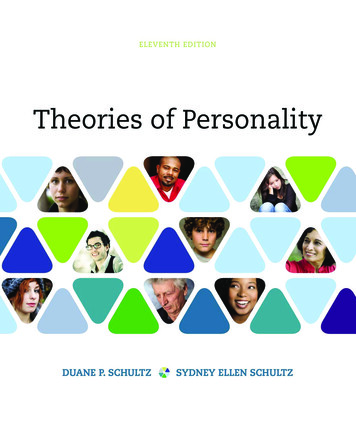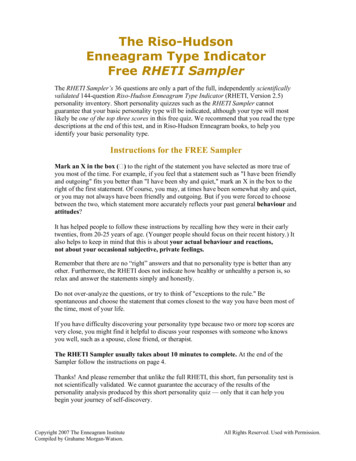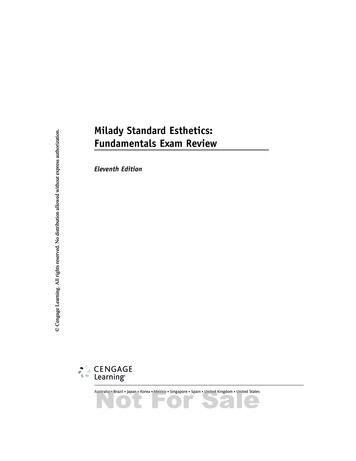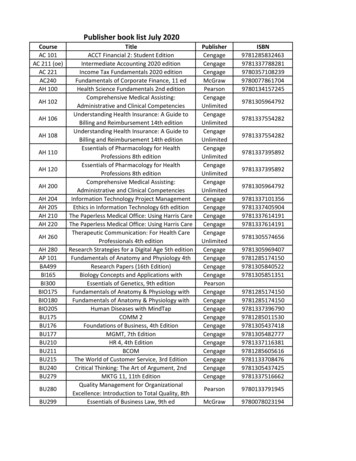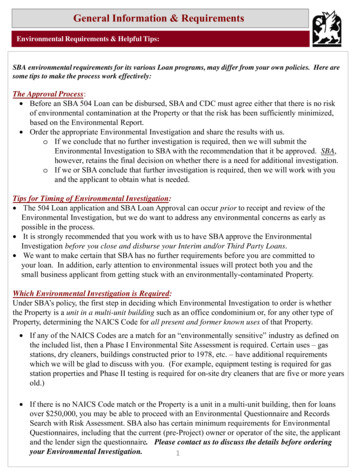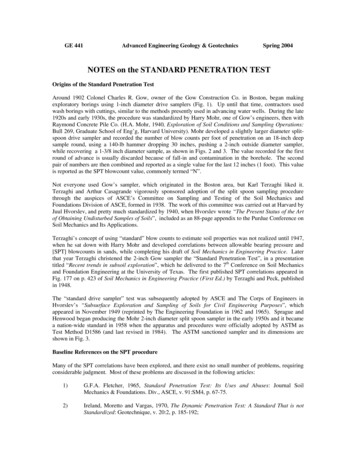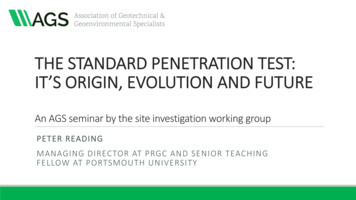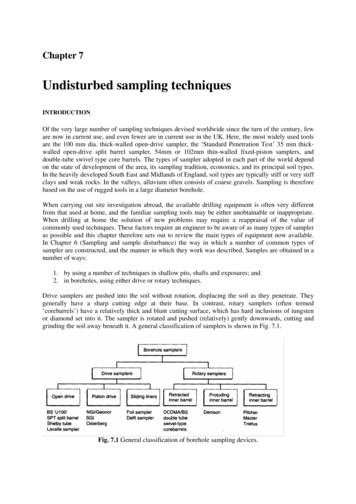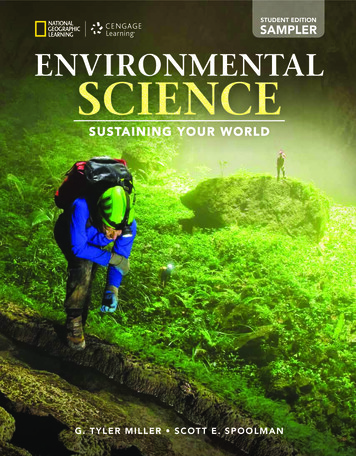
Transcription
STUDENT EDITIONSAMPLERENVIRONMENTALSUSTAI NING YOUR WORLDG . T Y L E R M I L L E R S C O T T E. S PO O L MAN
Transport Students intoEnvironmental Science withNational Geographic LearningENVIRONMENTALElevate Environmental Science instruction with the first high school programbuilt with National Geographic images and Explorers.Promote scientific understanding of environmental issuesS U S TA INING Y O U R W O R L DDevelop real-world science practices with Explorers as examplesEncourage critical thinking skillsGO DIGITAL with MindTapIncrease student engagement with anenhanced, media-rich eBook, onlineassessments, and study tools.Personalize the course to meet your needsTrack student progress and success withpowerful analyticsEasily create assignments and remindersfor studentsCONNECT to theNext Generation Science StandardsAddress the Next Generation Science Standardsto ensure your students meet 21st century scienceskills and practices.Teach the 3-dimensions with instruction for theDisciplinary Core Ideas, Science and EngineeringPractices, and Crosscutting ConceptsIncorporate engineering with comprehensiveunit projectsMulti-disciplinary approach with standards fromearth, life, physical, and technology sciences*is a registered trademark of Achieve. Neither Achieve nor the lead statesand partners that developed the Next Generation Science Standards wasinvolved in the production of, and does not endorse, this product.”*ON ASSIGNMENT National Geographicphotographer Carsten Peter accompanieda group of explorers to document theuntouched subterranean beauty ofVietnam’s Hang Son Doong. The enormouscave is part of a national park, which wasnamed a World Heritage site in 2003.Although longer and deeper caves havebeen discovered, none are as large as HangSon Doong, which could easily fit several40-story skyscrapers.
About the AuthorsG. TYLER MILLERCopyright 2017 National Geographic Learning, a partof Cengage LearningAcknowledgmentsGrateful acknowledgment is given to the authors,artists, photographers, museums, publishers, andagents for permission to reprint copyrighted material.Every effort has been made to secure the appropriatepermission. If any omissions have been made or ifcorrections are required, please contact the Publisher.Photographic CreditsCover Carsten Peter/National Geographic Creative.Inside Front Cover Can Yesil/Shutterstock.com TitlePage (bg) Carsten Peter/National Geographic Creative.v (tl) Shah Selbe. vi (cl) Stephen Saks/Lonely PlanetImages/Getty Images. viii (cr) Karine Aigner/Meet YourNeighbours/iLCP. 3 (tr) Shah Selbe. (cr) Karine Aigner/Meet Your Neighbours/iLCP. (br) Stephen Saks/LonelyPlanet Images/Getty Images. 64 Paul Harris/AMLImages/Getty Images. 67 (t, bl, br) Robin Moore. 68(bl, br) U.S. Department of the Interior U.S. GeologicalSurvey. 70 (t) Frans Lanting/National GeographicCreative. 74 (bg) Frans Lanting/National GeographicCreative. 77 (t) Eye of Science/Science Source. 79 (b)Roy Toft/National Geographic Creative. 84 (bg) PeterMcBride/National Geographic Creative. 91 (bg) 2011Drew Fulton. 92 (cl) Sue Cunningham Photographic/Alamy Stock Photo. 93 (t) NASA Goddard Space FlightCenter Image by Reto Stöckli (land surface, shallowwater, clouds). Enhancements by Robert Simmon(ocean color, compositing, 3D globes, animation). Dataand technical support: MODIS Land Group; MODISScience Data Support Team; MODIS AtmosphereGroup; MODIS Ocean Group Additional data: USGSEROS Data Center (topography); USGS TerrestrialRemote Sensing Flagstaff Field Center (Antarctica);Defense Meteorological Satellite Program (city lights).205 (b) Leonardo Patrizi/iStock/Getty Images.ALL RIGHTS RESERVED. No part of this work coveredby the copyright herein may be reproduced ordistributed in any form or by any means, except aspermitted by U.S. copyright law, without the priorwritten permission of the copyright owner.“National Geographic,” “National Geographic Society”and the Yellow Border Design are registeredtrademarks of the National Geographic Society Marcas RegistradasFor product information and technology assistance,contact us at Customer & Sales Support, 888-915-3276For permission to use material from this text orproduct, submit all requests online atwww.cengage.com/permissionsFurther permissions questions can be emailedtopermissionrequest@cengage.comNational Geographic Learning Cengage Learning1 N. State Street, Suite 900Chicago, IL 60602Cengage Learning is a leading provider of customizedlearning solutions with office locations around theglobe, including Singapore, the United Kingdom,Australia, Mexico, Brazil, and Japan. Locate your localoffice at www.cengage.com/global.Visit National Geographic Learning online atNGL.Cengage.comVisit our corporate website at www.cengage.comISBN: 9781305637429Printed in the USA.RR Donnelley, Willard, Ohio, USAPrint Number: 01G. Tyler Miller has written 62 textbooksfor introductory courses in environmentalscience, basic ecology, energy, andenvironmental chemistry. Since 1975, Miller’sbooks have been the most widely usedtextbooks for environmental science in theUnited States and throughout the world. Theyhave been used by almost 3 million studentsand have been translated intoeight languages.Miller has a professional background inchemistry, physics, and ecology. He has aPhD from the University of Virginia and hasreceived two honorary doctoral degrees forhis contributions to environmental education.He taught college for 20 years, and developedone of the nation’s first environmentalstudies programs, before deciding to writeenvironmental science textbooks full-timein 1975.He describes his hopes for the future as follows.had to pick a time to be alive, it would be the next“ If75I years.Why? First, there is overwhelming scientificevidence that we are in the process of seriouslydegrading our own life-support system. In other words,we are living unsustainably. Second, within yourlifetime we have the opportunity to learn how to livemore sustainably by working with the rest of nature,as described in this book.am fortunate to have three smart, talented, and“ Iwonderfulsons—Greg, David, and Bill. I am especiallyprivileged to have Kathleen as my wife, best friend,and research associate. It is inspiring to have abrilliant, beautiful (inside and out), and strong womanwho cares deeply about nature as a lifemate. She is myhero. I dedicate this book to her and to the earth.”SCOTT E. SPOOLMANScott Spoolman has more than 30 years ofexperience in educational publishing. He hasworked with Tyler Miller first as a contributingeditor and then as coauthor of Living in theEnvironment, Environmental Science, andSustaining the Earth. With Norman Myers, hecoauthored Environmental Issues and Solutions:A Modular Approach.Spoolman holds a master’s degree in sciencejournalism from the University of Minnesota.He has authored numerous articles in thefields of science, environmental engineering,politics, and business. He has also worked as aconsulting editor in the development of over70 college and high school textbooks in fieldsof the natural and social sciences.In his free time, he enjoys exploring theforests and waters of his native Wisconsinalong with his family—his wife, environmentaleducator Gail Martinelli, and his children, Willand Katie.Spoolman has the following to say about his collaborationwith Tyler Miller.am honored to be working with Tyler Miller as a“ Icoauthorto continue the Miller tradition of thorough,clear, and engaging writing about the vast andcomplex field of environmental science. I share TylerMiller’s passion for ensuring that these textbooks andtheir multimedia supplements will be valuable toolsfor students and instructors. To that end, we strive tointroduce this interdisciplinary field in ways that willbe informative and sobering, but also tantalizingand motivational.the flip side of any problem is indeed an opportunity,“ Ifthenthis truly is one of the most exciting times inhistory for students to start an environmental career.Environmental problems are numerous, serious, anddaunting, but their possible solutions generate excitingnew career opportunities. We place high priorities oninspiring students with these possibilities, challengingthem to maintain a scientific focus, pointing themtoward rewarding and fulfilling careers, and in doingso, working to help sustain life on the earth.”Print Year: 2016iiiPROTOTYPE PAGESPROTOTYPE PAGES
Jim EstesEcologist and Evolutionary BiologistNational Geographic GranteeNational GeographicConsultantChristopher ThorntonVice-Chair, Committee for Researchand ExplorationNational GeographicFeatured ExplorersRobert BallardOcean ExplorerNational GeographicExplorer-in-ResidenceKamaljit S. BawaConservation BiologistNational Geographic GranteeJohn FrancisBehavioral EcologistNational Geographic Grantee andVice President for Research,Conservation, and ExplorationChristopher GoldenEcologist and EpidemiologistNational GeographicEmerging ExplorerJerry GloverAgroecologistNational GeographicEmerging ExplorerJane GoodallPrimatologistNational GeographicExplorer-in-ResidenceVitor Osmar BeckerConservationistNational Geographic GranteeYu-Guo GuoChemistNational GeographicEmerging ExplorerSteve BoyesConservation BiologistNational GeographicEmerging ExplorerCaleb HarperUrban AgriculturalistNational GeographicEmerging ExplorerDan BuettnerAuthorNational Geographic FellowZeb HoganEcologist and PhotographerNational GeographicFellow and Emerging ExplorerJennifer BurneyEnvironmental ScientistNational GeographicEmerging ExplorerAlizé CarrèreWriter and BiologistNational GeographicYoung ExplorerOsvel Hinojosa HuertaConservationistNational GeographicEmerging ExplorerThomas E. LovejoyTropical and Conservation BiologistNational Geographic FellowT.H. CulhaneUrban PlannerNational Geographic BlackstoneInnovation Challenge GranteeJuan MartinezEnvironmentalistNational GeographicEmerging ExplorerLeslie DewanNuclear EngineerNational GeographicEmerging ExplorerNalini NadkarniForest Ecologist and ScienceCommunicatorNational Geographic GranteeDennis DimickConservationistNational Geographic EditorErin PettitGlaciologist and GeophysicistNational GeographicEmerging ExplorerSylvia EarleOceanographerNational GeographicExplorer-in-ResidenceivPROTOTYPE PAGESSandra PostelFreshwater ConservationistNational Geographic FellowAndrés RuzoGeologistNational GeographicYoung ExplorerEnric SalaMarine EcologistNational GeographicExplorer-in-ResidenceCONTENTSSPECIAL FEATUREInto the Okavango with National GeographicCASE STUDY Experimenting with a Forest2.1 What Do Scientists Do?Anna SavageEvolutionary GeneticistNational GeographicYoung ExplorerEngineering Focus: What Is Engineering?EXPLORERS AT WORK John Francis2.2 What Is Matter?Çağan Hakkı ŞekercioğluOrnithologist andConservation EcologistNational GeographicEmerging Explorer2.3 What Is Energy?2.4 What Are Systems?TYING IT ALL TOGETHER The Hubbard BrookForest ExperimentShah SelbeEngineer and ConservationTechnologistNational GeographicEmerging ExplorerSAMPLED PAGESCHAPTER 3Hayat SindiScience EntrepreneurNational GeographicEmerging ExplorerECOSYSTEM DYNAMICSEXPLORERS AT WORK Eco-Paradise at SerraBonita, with Vitor BeckerUNIT 1ECOLOGY AND ECOSYSTEMSCHAPTER 1Gregg TreinishAdventurer and ConservationistNational GeographicEmerging ExplorerTHE ENVIRONMENT AND SUSTAINABILITYAnand VarmaNatural History PhotographerNational GeographicYoung ExplorerCASE STUDY The Greening of American SchoolsKatey Walter-AnthonyAquatic Ecologist and BiogeochemistNational GeographicEmerging Explorer and BlackstoneInnovation Challenge GranteeEdward O. WilsonBiologist and AuthorNational GeographicHubbard Award recipientXiaolin ZhengNanoscientistNational GeographicEmerging ExplorerSCIENCE, MATTER, ENERGY, AND SYSTEMSEXPLORERS AT WORK New Paths to EngagingScience, with Nalini NadkarniJoel SartorePhotographerNational Geographic FellowTristram StuartAuthor and CampaignerNational GeographicEmerging ExplorerCHAPTER 2EXPLORERS AT WORK Reconnecting People withNature, with Juan Martinez1.1 What Are Some Key Factors ofSustainability?1.2 How Are Our Ecological FootprintsAffecting Earth?1.3 What Causes Environmental Problems andWhy Do They Persist?1.4 What Is an Environmentally SustainableSociety?EXPLORERS AT WORK Dennis DimickCASE STUDY Disappearing Tropical Rain Forests3.1 What Are Earth’s Major Spheres, and How DoThey Support Life?Science Focus: Nutrient Cycling3.2 What Are the Major Ecosystem Components?Engineering Focus: Nature’s Cleanup Crew3.3 What Happens to Energy in an Ecosystem?3.4 What Happens to Matter in an Ecosystem?Science Focus: Water3.5 How Do Scientists Study Ecosystems?EXPLORERS AT WORK Thomas E. LovejoyScience Focus: Testing Planetary BoundariesTYING IT ALL TOGETHER The Energy Cost ofCutting Rain ForestsUNIT 1 ENGINEERING PROJECTDesign a Method for Treating Contaminated SoilTYING IT ALL TOGETHER The Greening of the AmericanMindsetvPROTOTYPE PAGES
CONTENTSUNIT 2BIODIVERSITY6.1 What Factors Influence Climate?CHAPTER 46.2 What Are the Major Types of TerrestrialBIODIVERSITY AND EVOLUTIONEXPLORERS AT WORK Fighting a DeadlyFrog Disease, with Anna SavageCASE STUDY Amphibians at Risk4.1 What Is Biodiversity and Why Is It Important?Science Focus: Insects and EcosystemServices4.2 What Roles Do Species Play in Ecosystems?4.3 How Does Life on Earth Change Over Time?EXPLORERS AT WORK E.O. Wilson4.4 What Factors Affect Biodiversity?Science Focus: Geological Processes andBiodiversityScience Focus: Greenhouse GasesEcosystems?Science Focus: Desert AdaptationsEXPLORERS AT WORK Alizé Carrère6.3 What Are the Major Types of MarineEcosystems?Ecosystems?TYING IT ALL TOGETHER Coral Reef RecoveryUNIT 2 ENGINEERING PROJECTDesign a System to Assess a Local SpeciesSPECIAL FEATUREPartners in Sustainability: Nature Museums andPreservestying it all together Colony CollapseDisorderchapter 8SuStaining biodiverSity: an ecoSyStemSapproachexplorerS at Work Protecting BiodiversityOne Bird at a Time, with Çağan ŞekercioğlucaSe Study Costa Rica—A GlobalConservation Leader8.1 How Can People Manage Forests MoreSustainably?8.3 How Can People Manage Protected LandsEXPLORERS AT WORK Sea Otters Step Up, withJim EstesMore Sustainably?8.4 How Can the Ecosystems Approach HelpCASE STUDY The Southern Sea Otter: A Speciesin RecoveryProtect Terrestrial Biodiversity?explorerS at Work Kamaljit Bawa5.1 How Do Species Interact?8.5 How Can the Ecosystems Approach HelpProtect Aquatic Biodiversity?5.2 How Do Ecosystems Respond to ChangingTYING IT ALL TOGETHER Southern Sea OttersFace an Uncertain FutureEcosystem Services?Science Focus: Wildlife Forensics8.2 How Can People Manage Grasslands MoreSPECIES INTERACTIONS, SUCCESSION, ANDPOPULATION CONTROLEXPLORERS AT WORK Zeb Hogan7.3 How Can We Sustain Wild Species andSustainably?Science Focus: The Value of EcosystemServicesCHAPTER 55.3 What Limits the Growth of Populations?Species and Ecosystem Services?Science Focus: Honeybee Losses6.4 What Are the Major Types of FreshwaterTYING IT ALL TOGETHER Piecing Together thePuzzle of Chytrid DiseaseConditions?7.2 What Role Do Humans Play in the Loss ofUNIT 3SUSTAINING BIODIVERSITYCHAPTER 7SAVING SPECIES AND ECOSYSTEM SERVICEStying it all together Rates of TropicalForest Lossunit 3 engineering projectDesign a Solar CookercaSe Study Growing Power—An UrbanFood Oasis9.1 What Is Food Security?9.2 How Is Food Produced?9.3 How Are Environmental Issues and FoodProduction Connected?Science Focus: Soil ScienceexplorerS at Work Jerry Glover9.4 How Can Society Manage Agricultural PestsMore Sustainably?9.5 What Are Sustainable Solutions to FoodProduction?tying it all together Sustainability StartsWith Youchapter 10Water reSourceS and Water pollutionexplorerS at Work Rescuing the ColoradoRiver Delta, with Osvel Hinojosa HuertacaSe Study The Colorado River Story10.1 Why Is Fresh Water in Short Supply?10.2 How Can People Increase FreshwaterSupplies?Science Focus: Aquifer Depletion in theUnited States10.3 How Can People Use Freshwater ResourcesMore Sustainably?explorerS at Work Sandra Postel10.4 How Can People Reduce Water Pollution?engineering Focus: Working with Nature toTreat Sewagetying it all together Saving the ColoradoRiverEXPLORERS AT WORK Where Are theHoneybees? with Anand VarmaUNIT 4ENVIRONMENTAL QUALITYchapter 11ECOSYSTEMS AND CLIMATECASE STUDY A Honeybee Mysterychapter 9EXPLORERS AT WORK Saving the Last WildPlaces in the Ocean, with Enric Sala7.1 What Causes Extinction and What Are ItsFood, Soil, and peSt managementgeology and nonreneWable mineralreSourceSCHAPTER 6CASE STUDY The Importance of Coral ReefsviPROTOTYPE PAGESImpacts?EXPLORERS AT WORK Joel SartoreexplorerS at Work Sustainable Agriculture: IsIt Possible? with Jennifer BurneyexplorerS at Work Better Batteries forElectric Cars, with Yu-Guo GuoviiPROTOTYPE PAGES
ContentscaSe Study The Importance of Rare EarthMetals13.2 What Are Sources of Renewable Energy?11.1 How Do Geological Processes Relate to13.3 How Can Society Transition to MoreSociety and the Environment?11.2 What Are Earth’s Mineral Resources andHow Long Might Reserves Last?explorerS at Work Bob Ballard11.3 What Are the Environmental Effects of UsingMineral Resources?11.4 How Can Society Use Mineral ResourcesMore Sustainably?Science Focus: The NanotechnologyRevolutionexplorerS at Work Xiaolin ZhengSustainable Energy Practices?engineering Focus: Green Citytying it all together Wind Power andSustainabilityunit 4 engineering projectDesign a Wind-Powered GeneratorSpecial FeatureCitizen Science and National Geographic’sBioBlitzestying it all together Rare Earth Metals andSustainability14.4 How Can Cities Become More Sustainable?EXPLORERS AT WORK Caleb HarperEngineering Focus: Curitiba’s TransportationSystemTYING IT ALL TOGETHER Analyzing PopulationGrowthCHAPTER 15HUMAN HEALTHEXPLORERS AT WORK Low-Tech Diagnostics,with Hayat SindiCASE STUDY Mercury’s Toxic Effects15.1 What Major Health Hazards Do We Face?EXPLORERS AT WORK Dan Buettner15.2 What Types of Biological HazardsDo We Face?Science Focus: Genetic Resistance toAntibioticschapter 12nonreneWable energy reSourceSexplorerS at Work Safer Nuclear Energy,with Leslie Dewan15.3 What Types of Chemical HazardsDo We Face?Science Focus: The Controversy Over BPAcaSe Study The Keystone XL Pipeline12.1 What Is Net Energy and Why Is It12.3 What Are the Advantages and Disadvantagesof Using Nuclear Energy?Science Focus: Nuclear Fission ReactorsUNIT 5ENVIRONMENTAL CONCERNSchapter 14tying it all together Life with Fossil Fuelshuman population and urbanizationchapter 13explorerS at Work The People-Planet Link,with Christopher GoldenreneWable energy reSourceScaSe Study Population Seven BillionexplorerS at Work The Boiling River, withAndrés Ruzo14.1 How Many People Can Earth Support?caSe Study The Potential for Wind Power in theUnited States14.2 What Factors Influence Human Population13.1 Why Is Energy Efficiency an Important14.3 What Are the Effects of Urbanization on theEnergy Resource?viiiPROTOTYPE PAGESScience Focus: The Population DebateGrowth?Environment?EXPLORERS AT WORK The Social Impacts of FoodWaste, with Tristram StuartCASE STUDY E-Waste—An Exploding Problem17.1 What Are Problems Related to Solid andHazardous Waste?17.2 How Should Solid Waste be Handled?Science Focus: BioplasticsEXPLORERS AT WORK T.H. Culhane17.3 How Should Hazardous Waste be Handled?17.4 How Can Society Transition to a Low-WasteEconomy?TYING IT ALL TOGETHER Eliminating Food WasteCHAPTER 18ENVIRONMENTAL ECONOMICS, POLITICS, ANDWORLDVIEWSEXPLORERS AT WORK Adventurers and Scientistsfor Conservation (ASC), with Gregg TreinishCASE STUDY The United States, China, andSustainabilityCHAPTER 1618.1 How Are Economic Systems Related to theAIR POLLUTION, CLIMATE CHANGE,AND OZONE DEPLETIONof Using Fossil Fuels?explorerS at Work Katey WalterAnthonySOLID AND HAZARDOUS WASTETYING IT ALL TOGETHER Staying SafeImportant?12.2 What Are the Advantages and DisadvantagesCHAPTER 17EXPLORERS AT WORK The Big Melt, withErin PettitCASE STUDY Melting Ice in Greenland16.1 What Are the Major Air Pollution Problems?Science Focus: Indoor Air Pollution16.2 What Are the Effects of Climate Change?EXPLORERS AT WORK Sylvia EarleScience Focus: Using Models to PredictChange16.3 How Can People Slow Climate Change?Biosphere?Science Focus: Biosphere 2–A LessonIn Humility18.2 How Can People Use Economic Tools toAddress Environmental Problems?18.3 How Can Society Enact More Sustainableand Just Environmental Policies?EXPLORERS AT WORK Jane Goodall18.4 How Can Society Live More Sustainably?TYING IT ALL TOGETHER A Sustainable WorldUNIT 5 ENGINEERING PROJECTDesign a Carbon-Capturing DeviceEngineering Focus: Carbon Capture16.4 How Can People Reverse Ozone Depletion?TYING IT ALL TOGETHER Melting Ice andSustainabilityixPROTOTYPE PAGES
CHAPTER 3ECOSYSTEMDYNAMICSAmAzoniA, a region loosely defined as the Amazon River Basin, covers an area of landKEY QUESTIONSabout the size of the 48 contiguous United States. A tenth of Earth’s species are thought3.1 What are Earth’s major spheres, and howdo they support life?to live in Amazonia, which includes half of the planet’s tropical rain forests. People havelived in this region for at least 13,000 years. In the past 50 years, however, human activityhas destroyed close to 20% of Amazonia’s rain forest.64PROTOTYPE PAGES3.2 What are the major ecosystemcomponents?3.3 What happens to energy in an ecosystem?3.4 What happens to matter in an ecosystem?3.5 How do scientists study ecosystems?The Nanay River in Peru is one of the Amazon River’s many tributaries.65PROTOTYPE PAGES
ExPlORERS AT WORKVitor Becker researches hummingbirdsand insects at Serra Bonita, a naturereserve in the Atlantic Forest. Todayonly 8% of the Atlantic Forestremains—another reason whyprotecting places like Serra Bonita isso important.Eco-Paradise atSerra Bonitawith National Geographic Explorer Vitor BeckerVitor Becker takes a few moments each day to dosomething that hardly anyone else in the world cando: He feeds a buzzing flock of tiny hummingbirdsfrom the palm of his hand. As you might imagine, thisisn’t something that happens in a suburban backyard,but at Serra Bonita, a nearly-2,225 hectare (5,000acre) nature reserve named for the Serra BonitaMountain in the Atlantic Forest of Brazil.About the Atlantic Forest: There’s good news andbad news. It’s one of the most diverse biomes in theworld. It is also one of the most destroyed in Brazil—only 8% of its original forests remain. Still, the regioncontinues to have very high species diversity. In fact,protected areas like Serra Bonita are a refuge forthousands of species not found anywhere else in theworld. This lush rain forest and the species it nurtureslead Becker to call Serra Bonita an “eco-paradise.”Dr. Becker studied forestry and trained as anentomologist, which is a scientist who studiesinsects. He, his wife, and their daughter—with helpfrom National Geographic and many others—all workto maintain the reserve. Think about these numbers:More than 350 bird species, roughly 1,200 vascularplant species, and more than 70 frog species havebeen identified at Serra Bonita. Protecting them is nosmall task. The Brazilian rain forest is often a difficultplace for conservationists to work because of illegallogging operations and other threats.66Chapter 3e Cos ys t e m dy n a m i C sPROTOTYPE PAGESDespite that, the family plans to expand thereserve—and is committed to education too. Theresearch center at Serra Bonita holds laboratories,collection rooms, and a library, and supports manyresearch projects that yield new information nearlyevery day.Hummingbirds aren’t Becker’s only concern—thereare also the thousands of moth species he hasidentified at Serra Bonita. Check out online videos onSerra Bonita, and you’ll find howler monkeys sittingon his shoulders. And, though you won’t see them inthe videos, Becker knows puma prowl through thereserve, now free from threat by hunters.The Serra Bonita website offers ideas for how toget involved in this great project, but there aremany ways to take up the causes of ecosystemconservation and species preservation. You couldstart by asking questions about your own region.What plants and animals live there, and are theythriving—or just barely surviving? Consider starting acitizen science project to identify species in the area.Look for ways you can help and then set out to do it.Thinking CriticallyDraw Conclusions Even though only 8% of the originalforests remain, the Atlantic Forest is still considered one ofthe most diverse regions on Earth. Can you conclude fromthese facts that the loss of forests has had little effect so faron the number of species found there? Why or why not?67PROTOTYPE PAGES
CASE STUDYDisappearing Tropical Rain ForestsTropical rain forests support anincredible variety of life. Theycover only about 7% of Earth’sland surface but contain half of theplant and animal species found onland. These lush forests are warmand humid year-round because oftheir daily rainfall and nearness tothe Equator. The biodiversity oftropical rain forests makes theman excellent natural laboratoryfor the study of ecosystems.An ecosystem is one or morecommunities of organisms thatinteract with one another and theirnonliving environment.To date, human activities havedestroyed or disturbed morethan half of Earth’s tropical rainforests. People continue clearingthe forests to grow more crops,graze more cattle, and buildmore settlements. Ecologistswarn that without protection,most of the forests will be goneor severely damaged by the endof this century. The preservationefforts of individuals like NationalGeographic Explorer Vitor Beckerhelp combat the degradation ofecosystems.Removing tropical rain forestsreduces Earth’s vital biodiversity,or the planet’s variety of speciesand the habitats where theylive. (See Chapter 4 for moreabout biodiversity.) Destroyingthe habitats of plant and animalspecies often results in theirextinction. When the forest losesa key species, it can have a rippleeffect that leads to the loss ofother species.Destroying tropical rainforests also accelerates globalwarming. Without tropical rainforests, the atmosphere warms,leading to climate change. Why?Eliminating large areas of treesmeans there are fewer plants toremove carbon dioxide (CO2 )during photosynthesis. Carbondioxide is a gas that contributesto atmospheric warming. (SeeChapter 16 for more about climatechange.)Large-scale loss of tropical rainforests can also change regionalweather patterns in ways thatprevent the forest from returning.When this irreversible tippingpoint is reached, rain forestsJune 197568Chapter 3e Cos ys t e m dy n a m i C sPROTOTYPE PAGESbecome dryer, less diversetropical grasslands. The presenceof grasslands decreases rainfallin nearby forests, which furtherweakens them.In this chapter, you willexamine the living and nonlivingcomponents of ecosystems andhow they function. You will learnhow ecosystems support life, howecologists study the interactionswithin and among differentecosystems, and the importance ofmaintaining ecosystem integrity.Healthy tropical rain forests likethe one preserved at Serra Bonitaare examples of sustainablyfunctioning ecosystems.As You Read Think about anecosystem where you live.Consider what makes it unique,as well as what it might havein common with a rain forestecosystem. Which part of theecosystem is most damagedor threatened? How might thisaffect the other parts of theecosystem and its long-termsustainability?July 2013FigurE 3-1Satellite images of thesame area show theloss of tropical rainforest near the Boliviancity of Santa Cruz de laSierra. The forest wascleared for farming,cattle grazing, andsettlements betweenJune 1975 (left) andJuly 2013 (right).3.1 What Are Earth’s MajorSpheres, and How Do TheySupport Life?CORE IDEAS AND SKIllS Describe the four major spheres thatsupport life on Earth. Understand how nutrients cycle and energy flowsthrough ecosystems.KEY rospherebiospheregreenhouseeffectEarth’s Spheres Function As alife-Support SystemEarth’s “life-support system” is based on theinteraction among four planetary systems, orspheres: the atmosphere, hydrosphere, geosphere,and biosphere (Figure 3-2). The natural capital(resources and ecosystem services) on which lifedepends is the product of Earth’s spheres and energyfrom the sun.extends up to 6 kilometers (4 miles). Life in theatmosphere has evolved to tolerate the temperatureranges and composition of gases only within thetroposphere.The stratosphere is the atmospheric layer abovethe troposphere. Although nothing lives in thestratosphere, this layer has a direct impact on lifeat the surface. The lower stratosphere contains arelatively high concentration of ozone (O3 ), which iscalled the ozone layer. The ozone layer absorbs morethan 95% of the sun’s harmful UV radiation. It acts asa global sunscreen that allows life to exist on Earth’ssurface.Three more atmospheric layers extend forhundreds of kilometers beyond the stratosphere: themesosphere, the thermosphere, and the exosphere.Together, these five layers of the atmosphere protectEarth from the extremes of space.FigurE 3-2Earth’s Spheres Earth consists of a land sphere (geosphere),an air sphere (atmosphere), a water sphere (hydrosphere), and alife sphere (biosphere).The Geosphere The geosphere consists ofEarth’s core, mantle, and thin outer crust—all thematerial above and below the surface that formsthe planet’s mass. Without its large mass, Earthwould not have the gravitational force needed tokeep the atmosphere from escaping into space. Thegeosphere’s upper crust contains nutrients organismsneed to live, grow, and reproduce (Science Focus 3.1).The crust also includes nonrenewable fossil fuels—coal, oil, and natural gas—and mineral resources.The Atmosphere Held to Earth by gravity, theatmosphere is an envelope of gases surroundingthe planet (Figure 3-4). If Earth were the size of abasketball, the atmosphere would be about the
Vietnam’s ang Son Doong The enormous cave is part o a national park which was named a orld eritage site in 003 Although longer and deeper caves have been discovered none are as large as ang Son Doong which could easily it several 40-story skyscrapers. ENVI_SCI_TITLEPAGE_.indd 3 2/4/16 4:26 PM Transport
